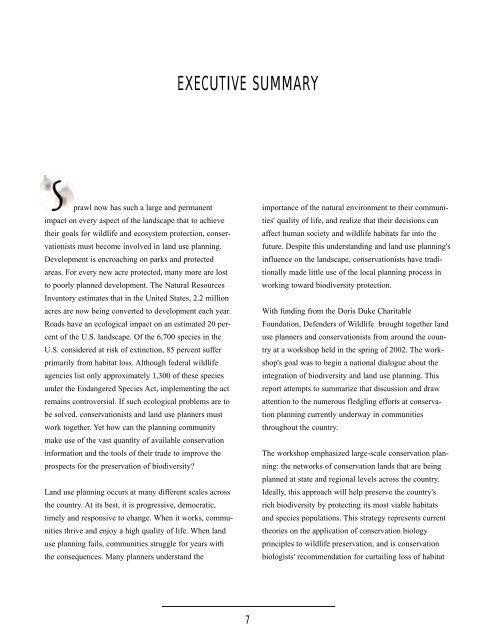Integrating Land Use Planning and Biodiversity - Defenders of Wildlife
Integrating Land Use Planning and Biodiversity - Defenders of Wildlife
Integrating Land Use Planning and Biodiversity - Defenders of Wildlife
You also want an ePaper? Increase the reach of your titles
YUMPU automatically turns print PDFs into web optimized ePapers that Google loves.
EXECUTIVE SUMMARY<br />
prawl now has such a large <strong>and</strong> permanent<br />
impact on every aspect <strong>of</strong> the l<strong>and</strong>scape that to achieve<br />
their goals for wildlife <strong>and</strong> ecosystem protection, conservationists<br />
must become involved in l<strong>and</strong> use planning.<br />
Development is encroaching on parks <strong>and</strong> protected<br />
areas. For every new acre protected, many more are lost<br />
to poorly planned development. The Natural Resources<br />
Inventory estimates that in the United States, 2.2 million<br />
acres are now being converted to development each year.<br />
Roads have an ecological impact on an estimated 20 percent<br />
<strong>of</strong> the U.S. l<strong>and</strong>scape. Of the 6,700 species in the<br />
U.S. considered at risk <strong>of</strong> extinction, 85 percent suffer<br />
primarily from habitat loss. Although federal wildlife<br />
agencies list only approximately 1,300 <strong>of</strong> these species<br />
under the Endangered Species Act, implementing the act<br />
remains controversial. If such ecological problems are to<br />
be solved, conservationists <strong>and</strong> l<strong>and</strong> use planners must<br />
work together. Yet how can the planning community<br />
make use <strong>of</strong> the vast quantity <strong>of</strong> available conservation<br />
information <strong>and</strong> the tools <strong>of</strong> their trade to improve the<br />
prospects for the preservation <strong>of</strong> biodiversity<br />
<strong>L<strong>and</strong></strong> use planning occurs at many different scales across<br />
the country. At its best, it is progressive, democratic,<br />
timely <strong>and</strong> responsive to change. When it works, communities<br />
thrive <strong>and</strong> enjoy a high quality <strong>of</strong> life. When l<strong>and</strong><br />
use planning fails, communities struggle for years with<br />
the consequences. Many planners underst<strong>and</strong> the<br />
importance <strong>of</strong> the natural environment to their communities'<br />
quality <strong>of</strong> life, <strong>and</strong> realize that their decisions can<br />
affect human society <strong>and</strong> wildlife habitats far into the<br />
future. Despite this underst<strong>and</strong>ing <strong>and</strong> l<strong>and</strong> use planning's<br />
influence on the l<strong>and</strong>scape, conservationists have traditionally<br />
made little use <strong>of</strong> the local planning process in<br />
working toward biodiversity protection.<br />
With funding from the Doris Duke Charitable<br />
Foundation, <strong>Defenders</strong> <strong>of</strong> <strong>Wildlife</strong> brought together l<strong>and</strong><br />
use planners <strong>and</strong> conservationists from around the country<br />
at a workshop held in the spring <strong>of</strong> 2002. The workshop's<br />
goal was to begin a national dialogue about the<br />
integration <strong>of</strong> biodiversity <strong>and</strong> l<strong>and</strong> use planning. This<br />
report attempts to summarize that discussion <strong>and</strong> draw<br />
attention to the numerous fledgling efforts at conservation<br />
planning currently underway in communities<br />
throughout the country.<br />
The workshop emphasized large-scale conservation planning:<br />
the networks <strong>of</strong> conservation l<strong>and</strong>s that are being<br />
planned at state <strong>and</strong> regional levels across the country.<br />
Ideally, this approach will help preserve the country's<br />
rich biodiversity by protecting its most viable habitats<br />
<strong>and</strong> species populations. This strategy represents current<br />
theories on the application <strong>of</strong> conservation biology<br />
principles to wildlife preservation, <strong>and</strong> is conservation<br />
biologists' recommendation for curtailing loss <strong>of</strong> habitat<br />
7
















![[PDF] Community Development Toolkit - CommDev](https://img.yumpu.com/48616495/1/184x260/pdf-community-development-toolkit-commdev.jpg?quality=85)
